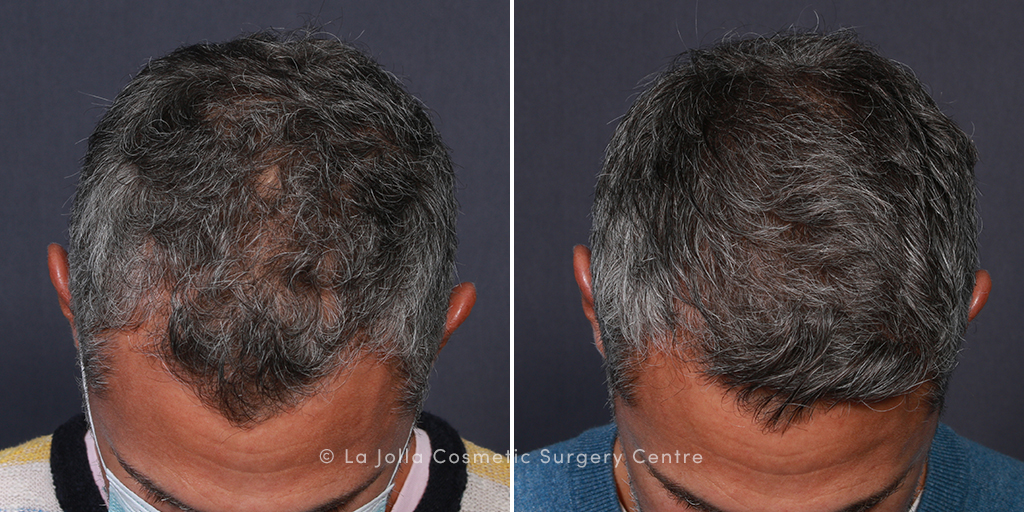
From strip excisions to Rogaine to SmartGraft®, you’ve never had more options for hair restoration. At San Diego’s La Jolla Cosmetic Surgery Centre, we meet with men and women all the time who know they’re ready to restore the full, healthy, bouncy hair of their dreams but don’t quite know which of the many approaches is best for them. It’s a lot to sort through—that’s why we’re here to help!
In this blog post, you’ll find answers to your biggest questions about hair loss, from why it happens to what you can do about it. Read on to learn how you can take your hair from thinning to winning.
What Causes Male & Female Hair Loss?
While many people associate hair loss with aging, that’s not always the case! There are many different reasons people of all genders experience hair loss.
Male and Female Pattern Baldness (Androgenic Alopecia)
The most common cause of hair loss is a hereditary condition called androgenic alopecia. It causes a receding hairline and bald spots for men and thinning around the crown for women.
Hormonal Changes
Post-pregnancy hair loss is a very real thing. Many women experience hair loss after giving birth, during menopause, or as a result of other hormonal imbalances. (Get answers to all your questions about women’s hair loss in this previous blog post.)
Stress
Ever felt so stressed you wanted to pull your hair out? You’re not alone! Some people experience temporary hair thinning after a stressful event. Sometimes this is caused by stress forcing hair follicles into a resting phase. It also may be a result of an anxiety response called trichotillomania, or hair pulling.
Medical Conditions (Alopecia Areata)
Some medical conditions may cause shedding. Alopecia areata is an immune disorder that causes unpredictable hair loss.
Tight Hairstyles (Traction Alopecia)
Love putting your hair up in a high ponytail or tight braids? You may want to give your scalp time to rest. Over time, that tension can cause thinning along your hairline.
Did you know: You lose 50 to 100 hairs every day, but this isn’t noticeable because new hair is growing at the same time. Hair loss (also called telogen effluvium) happens when not enough new hair is around to replace hair that has fallen out.
How Can I Prevent Hair Loss?
Some causes of hair loss, such as androgenic alopecia, aren’t really preventable. But there are a few things you can do to keep your hair as healthy as possible:
- Focus on nutrition: Eat a rich, healthy diet with plenty of vitamins and minerals. Studies recommend iron, zinc, protein, vitamin B12, vitamin C, and vitamin D.
- Stop smoking: On top of prematurely aging your skin, smoking is also known to cause hair thinning.
- Be gentle with your hair: Try not to tug on your tresses or pull them too tight for extended periods of time.
- Manage medications: Talk to your doctor about medications that may be causing hair loss and supplements that may be able to offset it.
If none of these solutions slow your hair loss and stimulate near hair growth to the extent you’re looking for, your next step may be to consider a hair restoration treatment.
What Is the Best Hair Restoration Treatment?

So you’re struggling with hair loss and want to restore your hair to its thick, shiny, bouncy prime. Where to begin? Most people start with one of the following solutions:
- Minoxidil (Rogaine): This over-the-counter product comes in liquid, foam, and shampoo forms. It may take a few months for you to see results.
- Finasteride (Propecia): This prescription drug for men comes as a daily pill designed to slow the rate of hair loss and increase growth.
- Follicular Unit Transfer (FUT): This hair transplant procedure, also called strip excision, involves removing a donor strip of hair from the back of the head and transplanting the follicles into areas of thinning.
- Follicular Unit Extraction (FUE): This procedure removes hair from donor areas in follicular units and transplants it to areas of thinning, leaving no linear scars.
While each approach offers its own benefits, we find FUE treatments are often the most effective option for long-term hair restoration.
All About Our Pick: SmartGraft FUE Hair Restoration
SmartGraft hair restoration is an advanced FUE system that uses automated technology to deliver a faster and more precise treatment with fantastic results.
How Does SmartGraft Work?
SmartGraft transfers follicular units of 1 to 4 follicles from a donor area on the back of your head to areas of thinning, such as the front of the hairline, the crown, and the temples.
At LJC, your treatment will be planned and directed by our hair restoration specialist, board-certified plastic surgeon Dr. Hector Salazar-Reyes. You’ll also get the full treatment with the SmartGraft BOOST System, which includes:
- SmartGraft FUE hair restoration
- Personalized hair growth supplements
- Shampoo and products from Hair Restoration Laboratories
It’s all about making sure you get the absolute most out of your experience—as you deserve!
How Much Does SmartGraft Cost?
The cost of a SmartGraft hair transplant at our San Diego med spa varies quite a bit depending on the number of follicles transferred. A personal consultation is the best way to get an accurate pricing estimate.
What Is It Like to Have SmartGraft Done?
SmartGraft procedures take about 5 hours and only require local anesthesia, so you’ll be awake and comfortable the whole time. You can request a mild sedative if you’d like to feel even more at ease. You’ll be free to watch movies, nap, and get up to use the restroom at any time.
Do I Have to Shave My Head First?
Nope! Your provider will shave a small part of your donor area before your procedure. We’ll be happy to get you in touch will local stylists who specialize in disguising these areas as they grow back out.
How Long Is SmartGraft Recovery?
Most people return to office work the very next day, but you’ll need to wait about a week to resume your exercise routine. It may take about 3 months for you to start noticing the difference in your hairline, with full results developing after about a year.
Where Do I Start?
No matter the cause or extent of your hair loss, rest assured that restoring the hair of your dreams is easier than ever! To see examples of what’s possible, please visit our before-and-after photo gallery.
If you would like to learn more or set up a consultation with a hair restoration specialist in San Diego, please contact us online or give us a call at (858) 452-1981. We can’t wait to hear from you!

